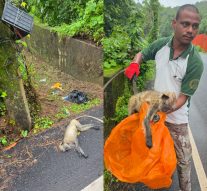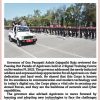Goa is abuzz with excitement as vintage bike and car owners, users, collectors and fans are decking […]

LANGUR HIT BY A PASSING VEHICLE DIES!By Dominick Rodrigues
Aug 30-Sept 05, 2025, Life & Living August 29, 2025IN Goa the Ganesh Chaturthi festival is celebrated widely in a holiday and festive mood in Goa, but those on emergency duty like Virendra Kaisurkar in the Forest Department still makes time to attend to the needs of a member of wildlife in distress.
I was returning to Mapuca via Siolim in North Goa earlier this week and was stunned to see a baby langur (monkey species with black markings) lying unconscious in at the foot of an electric pole at the roadside in Cruz Vaddo. It was so helpless and pathetic a sight that I quickly contacted the Forest Department where someone asked wildlife rescue daily wager Kaisurkar to rush with his jeep from the capital city of Panjim, mind you in the stormy rain and wild wind in the company of yours sincerely, a sometimes journo in Goa. I took him to the site where the langur was still lying in a stunned position.
On arriving we found the langur but he was cold dead, his body crawling with maggots and other underworld critters. He must have lain there dead for 24 hours with nobody taking an interest until I happened to come along.
Electrocution was ruled out due to the wires around about being covered with plastic, however it is possible that the baby langur (monkey tribe) was hit by a speeding vehicle, and was so badly injured that it wasn’t able to move away. Passers-by pathetically saw the langur in pain but did not bother to help the wild animal. Then I saw him and had to call the wildlife department, at least anyone can do this surely?
Kaisurkar gently wrapped the dead monkey’s body in a plastic bag and said it would be taken for post-mortem and then buried at the Campal forest department grounds where there is a burial ground for wildlife. He shared that there are sometimes cases of mother monkey with baby being hit by vehicles passing by as the creatures try to cross a stretch of road. It is particularly distre4ssing to see the babies crying for help which rarely comes.
If anything this incident highlights lack of concern or kindness for wildlife in distress and injured within sight, when someone passing by can easily make a phone call to the Forest Department and inform somebody who can rescue the injured animal and perhaps give it a new lease of life back in its forest home. What is the point in singing hosannas to wildlife and how it is in danger of extinction when the ordinary person at ground level doesn’t respond to cries of animals in distress but are in a hurry to go to their own homes safely. Clearly, there’s a need to foster a consciousness amongst lay people not to ignore wildlife in trouble in what is perceived as human spaces now.
Kaisurkar shares that during the heavy monsoon rain months this year they witnessed the rescue of some crocodiles, besides pythons, cobras and even a porcupine which had gone out of track in taking refuge in compounds of houses. Seeking emergency shelter from the heavy rains.
Some people have a false fear about porcupines which they imagine “shoots” its quills in self-defence if you try to save them from an ugly accident. But Kaisurkar has never seen this happen. Wild animals seem to know when they are being rescued and treated for their injuries and even express their gratitude in touching ways later on!
The forest department folk should run a campaign to educate the lay public how to safe wildlife in trouble and not to be “shit scared” of it that it is difficult to tell who is more scared, poor wild beast or cruel human beast.















